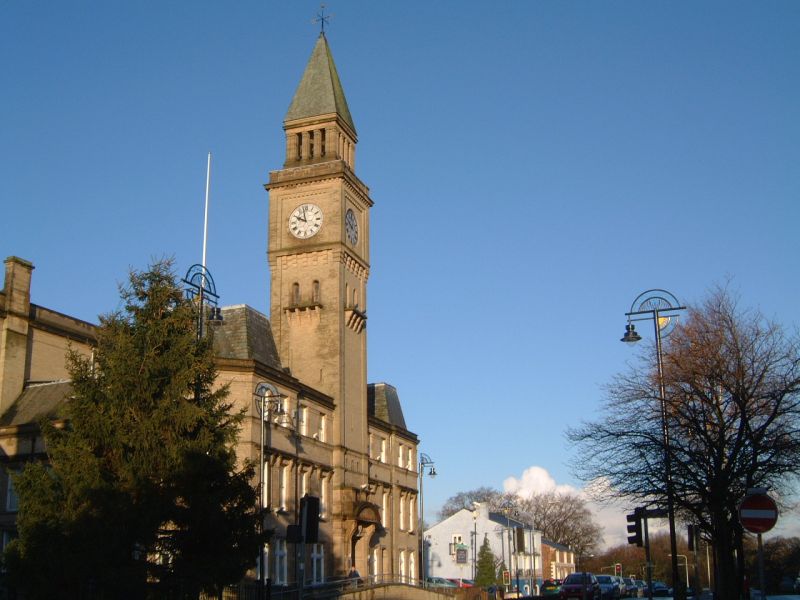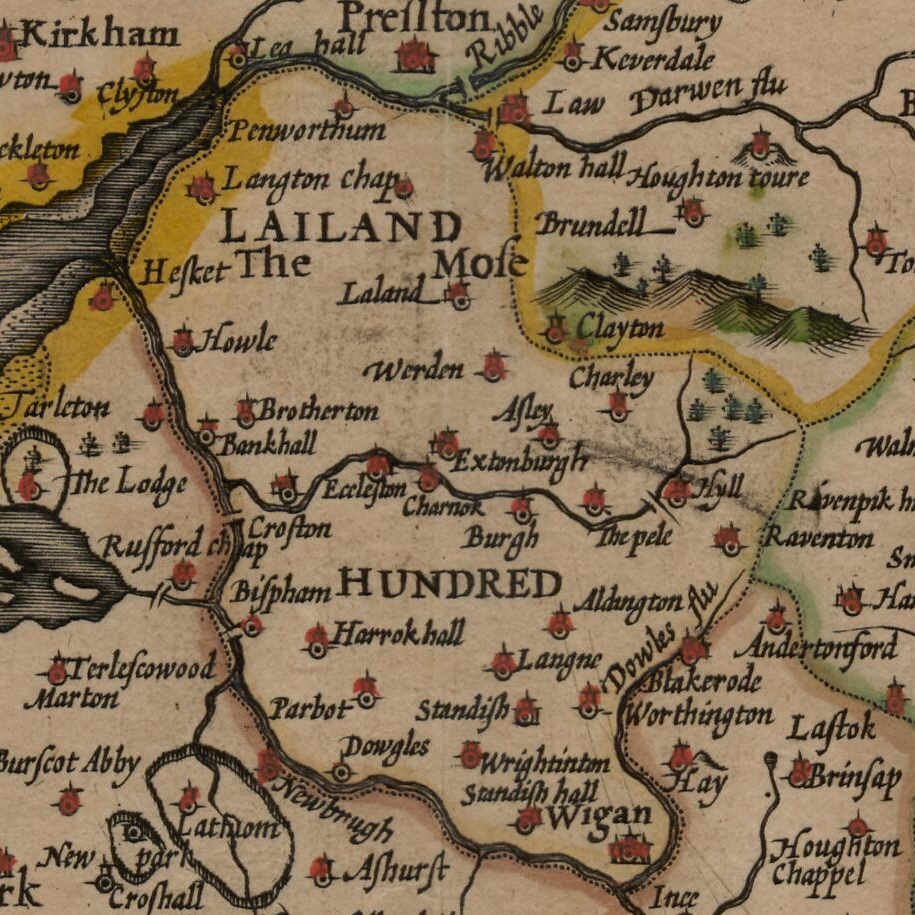|
Chorley, Lancashire
Chorley is a town and the administrative centre of the wider Borough of Chorley in Lancashire, England, north of Wigan, south west of Blackburn, north west of Bolton, south of Preston and north west of Manchester. The town's wealth came principally from the cotton industry. In the 1970s, the skyline was dominated by factory chimneys, but most have now been demolished: remnants of the industrial past include Morrisons chimney and other mill buildings, and the streets of terraced houses for mill workers. Chorley is the home of the Chorley cake. History Toponymy The name ''Chorley'' comes from two Anglo-Saxon words, and , probably meaning "the peasants' clearing". (also or ) is a common element of place-name, meaning a clearing in a woodland; refers to a person of status similar to a freeman or a yeoman. Prehistory There was no known occupation in Chorley until the Middle Ages, though archaeological evidence has shown that the area around the town has been inhabited ... [...More Info...] [...Related Items...] OR: [Wikipedia] [Google] [Baidu] |
Town
A town is a human settlement. Towns are generally larger than villages and smaller than cities, though the criteria to distinguish between them vary considerably in different parts of the world. Origin and use The word "town" shares an origin with the German word , the Dutch word , and the Old Norse . The original Proto-Germanic word, *''tūnan'', is thought to be an early borrowing from Proto-Celtic *''dūnom'' (cf. Old Irish , Welsh ). The original sense of the word in both Germanic and Celtic was that of a fortress or an enclosure. Cognates of ''town'' in many modern Germanic languages designate a fence or a hedge. In English and Dutch, the meaning of the word took on the sense of the space which these fences enclosed, and through which a track must run. In England, a town was a small community that could not afford or was not allowed to build walls or other larger fortifications, and built a palisade or stockade instead. In the Netherlands, this space was a garden, mor ... [...More Info...] [...Related Items...] OR: [Wikipedia] [Google] [Baidu] |
Bronze Age
The Bronze Age is a historic period, lasting approximately from 3300 BC to 1200 BC, characterized by the use of bronze, the presence of writing in some areas, and other early features of urban civilization. The Bronze Age is the second principal period of the three-age system proposed in 1836 by Christian Jürgensen Thomsen for classifying and studying ancient societies and history. An ancient civilization is deemed to be part of the Bronze Age because it either produced bronze by smelting its own copper and alloying it with tin, arsenic, or other metals, or traded other items for bronze from production areas elsewhere. Bronze is harder and more durable than the other metals available at the time, allowing Bronze Age civilizations to gain a technological advantage. While terrestrial iron is naturally abundant, the higher temperature required for smelting, , in addition to the greater difficulty of working with the metal, placed it out of reach of common use until the end o ... [...More Info...] [...Related Items...] OR: [Wikipedia] [Google] [Baidu] |
Great Raid Of 1322
The Great Raid of 1322 was a major raid carried out by Robert the Bruce, during the First Scottish War of Independence, on Northern England between 30 September and 2 November 1322, resulting in the Battle of Old Byland. Numerous raids began by attacking the area around Carlisle, Holm Cultram Abbey and Northumberland, then eventually crossed over into North Yorkshire, resulting in property being burned and destroyed, valuables from the wealthy and abbeys being stolen, and some residents and livestock being captured and taken back to Scotland. After the death of Thomas of Lancaster whom Scotland supported as a means to cripple the English in their war against the Scottish during the Despenser War, the Scots in 1322 raided deeper into Northern England to gain his inheritance, reaching as far south as Chorley in Lancashire and the East Riding. They even raided the suburbs of York. A few abbeys, settlements and towns in the path of the raiders, such as Richmond, were spared by brib ... [...More Info...] [...Related Items...] OR: [Wikipedia] [Google] [Baidu] |
Croston
Croston is a village and civil parish near Chorley in Lancashire, England. The River Yarrow flows through the village. The population of the civil parish taken at the 2011 census was 2,917. History Croston was founded in the 7th century when St Aidan arrived at the riverside settlements. In the absence of a church, a cross was erected as a place of worship. The name is derived from the two Old English words 'cross' and 'tūn' (town/homestead/village) and is unique to the village. The parish of Croston was formerly far larger than it is today. It included Chorley, Much Hoole, Rufford, Bretherton, Mawdesley, Tarleton, Hesketh Bank, Bispham, Walmer Bridge and Ulnes Walton. These became independent parishes as a result of a series of separations between 1642 and 1821. A charter granted by Edward I in 1283 permitted an annual medieval fair and market to be held on the village green. Pre-20th Century maps also depict a castle which is believed to have been of a wooden constructio ... [...More Info...] [...Related Items...] OR: [Wikipedia] [Google] [Baidu] |
Leyland Hundred
The Leyland Hundred (also known as Leylandshire) is a historic subdivision of the English county of Lancashire. It covered the parishes of Brindle, Chorley, Croston, Eccleston, Hoole, Leyland, Penwortham, Rufford, Standish and Tarleton. In the Domesday Book the area was recorded as 'Lailand' Hundred, with Chorley Parish in Warmundestrou Hundred and Eccleston Parish in Duddeston Hundred, all included in the returns for Cheshire Cheshire ( ) is a ceremonial and historic county in North West England, bordered by Wales to the west, Merseyside and Greater Manchester to the north, Derbyshire to the east, and Staffordshire and Shropshire to the south. Cheshire's county t .... However, it cannot be said clearly to have been part of Cheshire.Crosby, A. (1996). writes on page 31: Notes and references Bibliography *Crosby, A. (1996). ''A History of Cheshire.'' (The Darwen County History Series.) Chichester, West Sussex, UK: Phillimore & Co. Ltd. . *Harris, B. E., and Thac ... [...More Info...] [...Related Items...] OR: [Wikipedia] [Google] [Baidu] |
Domesday Book
Domesday Book () – the Middle English spelling of "Doomsday Book" – is a manuscript record of the "Great Survey" of much of England and parts of Wales completed in 1086 by order of King William I, known as William the Conqueror. The manuscript was originally known by the Latin name ''Liber de Wintonia'', meaning "Book of Winchester", where it was originally kept in the royal treasury. The '' Anglo-Saxon Chronicle'' states that in 1085 the king sent his agents to survey every shire in England, to list his holdings and dues owed to him. Written in Medieval Latin, it was highly abbreviated and included some vernacular native terms without Latin equivalents. The survey's main purpose was to record the annual value of every piece of landed property to its lord, and the resources in land, manpower, and livestock from which the value derived. The name "Domesday Book" came into use in the 12th century. Richard FitzNeal wrote in the ''Dialogus de Scaccario'' ( 1179) that the book ... [...More Info...] [...Related Items...] OR: [Wikipedia] [Google] [Baidu] |
Heapey
Heapey is a village and civil parish of the Borough of Chorley, in Lancashire, England. The village is two miles from Chorley and on the western fringe of the West Pennine Moors. In 2001 the population was 955, increasing to 1,001 at the 2011 census. History Heapey derives from the Old English ''heope'' a rose, or ''heap'' a hill and ''hege'' a hedge meaning a rose hedge or hedge on the hill. It was recorded as Hepeie in 1219. There are ancient earthworks near Heapey and Roman coins were discovered in 1835. Heapey was part of ''Gunolfsmoors'' an area between Leyland and Blackburn claimed by a Viking, Gunnolf, in the 10th century. It emerged in the Middle Ages as Hepay in 1260. The lordship was held by the De Ollertons including Ranulph who assumed the Hepay name. Robert de Hepay sold the lordship to the Standishes, and the manor or lordship remained with them. In 1924, the principal landowners were the trustees of Mrs. Paulet and Mrs. Sumner Mayhew. There were 34 hearths liab ... [...More Info...] [...Related Items...] OR: [Wikipedia] [Google] [Baidu] |
Whittle-le-Woods
Whittle-le-Woods (commonly shortened to Whittle) is a village and civil parish of the Borough of Chorley in Lancashire, England. The population of the civil parish at the United Kingdom Census 2011, 2011 census was 5,434. Whittle-le-Woods lies on the A6 road (Great Britain), A6, about three miles north of the town of Chorley, and to the south of the city of City of Preston, Lancashire, Preston. It is divided into two areas, the older part on the old coach road running through Waterhouse Green to Brindle, Lancashire, Brindle and the more modern part on the A6 road where the church of St John is situated. In the north east is St Chad's RC Church and off the A6 is Shaw Hill Hotel, Golf and Country Club centred on the Shaw Hill Georgian mansion. It has experienced much residential development during the last twenty years. This has established the village as a popular commuter area, as it lies close to Preston and between the M6 motorway, M6 and M61 motorway, M61 motorways. Just o ... [...More Info...] [...Related Items...] OR: [Wikipedia] [Google] [Baidu] |
Roman Britain
Roman Britain was the period in classical antiquity when large parts of the island of Great Britain were under occupation by the Roman Empire. The occupation lasted from AD 43 to AD 410. During that time, the territory conquered was raised to the status of a Roman province. Julius Caesar invaded Britain in 55 and 54 BC as part of his Gallic Wars. According to Caesar, the Britons had been overrun or culturally assimilated by other Celtic tribes during the British Iron Age and had been aiding Caesar's enemies. He received tribute, installed the friendly king Mandubracius over the Trinovantes, and returned to Gaul. Planned invasions under Augustus were called off in 34, 27, and 25 BC. In 40 AD, Caligula assembled 200,000 men at the Channel on the continent, only to have them gather seashells ('' musculi'') according to Suetonius, perhaps as a symbolic gesture to proclaim Caligula's victory over the sea. Three years later, Claudius directed four legi ... [...More Info...] [...Related Items...] OR: [Wikipedia] [Google] [Baidu] |
Astley Hall (Chorley)
Astley Hall is a country house in Chorley, Lancashire, England. The hall is now owned by the town and is known as Astley Hall Museum and Art Gallery. The extensive landscaped grounds are now Chorley's Astley Park. History The site was acquired in the 15th century by the Charnock family from the Knights of St. John of Jerusalem. The Charnocks built the original timber-framed house, around a small courtyard, about 1575–1600. In 1665, Margaret Charnock married Richard Brooke of Mere in Cheshire (son of Sir Peter Brooke), and they built the present grand but asymmetrical front range of brick with a pair of vast mullion-and-transomed bay windows. This front has a doorway with distinctly rustic Ionic columns, remarkable at such a late date. The interior is notable for the staggering mid-17th century plasterwork in the ceilings of the Great Hall and drawing room, which have heavy wreaths and disporting cherubs. The ceilings are barbaric in their excesses, and the figures are rela ... [...More Info...] [...Related Items...] OR: [Wikipedia] [Google] [Baidu] |

.jpg)



